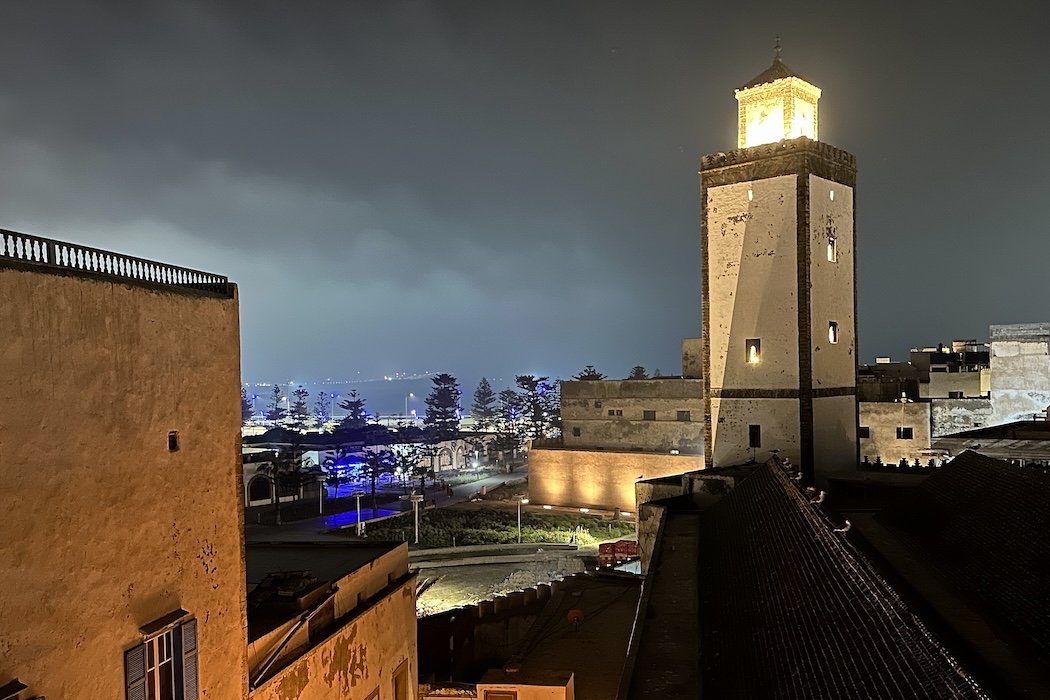Wander for fulfillment in Essaouira
View from an Essaouira rooftop towards the Atlantic Ocean at night
“We wander for distraction, but we travel for fulfillment.” – Hilaire Belloc
Located on the western Atlantic coast of Morocco 123 km (76 mi) north of Agadir, the ancient town of Essaouira is both an important port and a vibrant resort town that boasts a gently flat, curving, sandy beach. Its rich history dates back thousands of years because the bay is partially sheltered by an island, that protects it from strong trade winds and makes for a good anchorage spot. The largest of the islands, Iles Purpuraires, Mogador meant “small fortress” in Phoenician. Many civilizations utilized the site: Carthaginians established a trading post; Mauritanians produced Tyrian purple dye from murex and purpura shells; Roman merchants settled. In 1506, the Portuguese built a fortress, and Essaouira was known as Mogador until the 1960s. The name remains, now in Moroccan Arabic, which translates as beautifully designed small fortress.
Modern Essaouira was founded by King Mohammed III in the mid-18th century as a Medina protected by high stone ramparts, the Skala de la Kasbah. Designed and built by European architects and engineers as a city adapted to the needs of foreign merchants and diplomats, Essaouira thrived. The city experienced a golden age as a major commercial port for the trade of caravan goods coming out of Africa’s interior destined for overseas.
The town now truly reflects modern Morocco. It feels diverse and multicultural, with a blend of Berber, Arab, and European influences in its architecture and people. It is colorful, energetic, and bustling. Yet, in this off-the-beaten-path town of 80,000 residents, the smells, sounds, and vibrant colors do not lead to sensory overload in the narrow streets, as can be the case in Morocco’s larger cities. Any chaos of shouting vendors is reserved for the unloading and selling of fish in the daily market which takes place just outside the city walls in front of the Genoese-built citadel. That is a lively sight to see and experience.
While Essaouira remains a major fishing harbor, the town also welcomes domestic summer beach guests. The Alizée trades winds can blow strong, yet the bay is relatively waveless, so the crescent-shaped beach is popular for surfing, windsurfing, and kitesurfing. With its boardwalk, playgrounds, and fish restaurants, the beach is also famous for beautiful sunsets, and a relaxed atmosphere, both during the day and after dark.
Of the several picturesque city gates, the Port de la Marine leads out to a broad promenade at the oceanside, and the Bab Manjana is adorned with a pretty clocktower and a promenade lined with palm trees and benches. On the seaward side of the old town, or Medina, the high ramparts are lined with old brass Dutch-made cannons, and inside, the small streets and covered alleyways remain cool. Wandering around corners and through passageways leads to smaller and grander squares, peaceful indoor gardens, and several mosques.
The Medina also houses innumerable small arts and crafts businesses that create and sell textiles, faience pottery, jewelry, glassware, carpets, or wood carvings using centuries-old practices and the roots of the Tetraclinis tree, (a type of cypress), and much more. Essaouira is also the center of Argan oil production, an edible oil, which is used with bread or for couscous and pasta. Essaouiran sellers are generally friendly and informative in French, and a little English combined with hand signals, without being presumptuous.
Don’t Miss:
Witnessing the daily catch come in at the harbor front and the bustle of the fish market.
Serendipity:
Locals along the way- Communicating in hand signals with an older man to purchase an intricately inlaid wooden box and wanting to pay him more than his asking price.
Lunch Tip:
Sweet or savory crepes and freshly squeezed orange juice or Moroccan mint tea at one of the creperies on the main square Place Moulay Hassan.
Dinner Tip:
Restaurant Taros rooftop for the freshly caught fish of the day.
Bedtime:
Hôtel Riad Nakhla in a side street in the Medina for an intimate and authentic stay.
Subscribe for inspiration to have my posts drop directly into your inbox. *If you enjoyed what you read, please share this post with like-minded travelers.*
*All photographs are mine, taken with my Nikon D5600 or iPhone 14 Pro.*











